2020年杭州师范大学初试自命题科目考试大纲821课程与教学论
- 格式:doc
- 大小:38.00 KB
- 文档页数:2
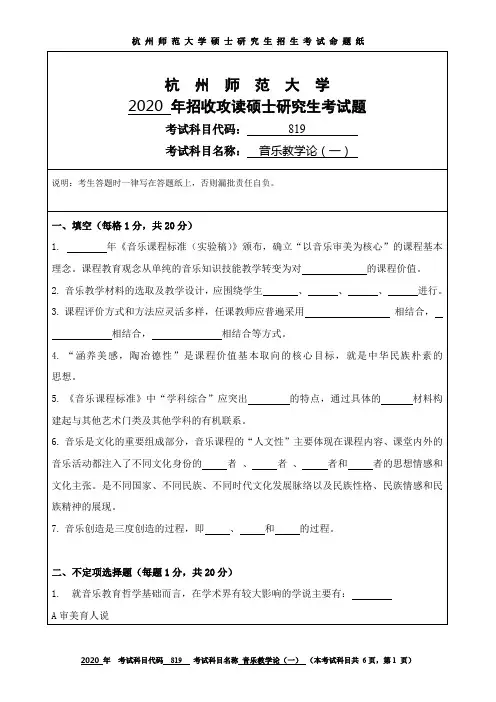

杭州师范大学2020年招收攻读硕士研究生考试题考试科目代码:861考试科目名称:中学生物教学论说明:考生答题时一律写在答题纸上,否则漏批责任自负。
一、生物学素养测试题(30分)1、人的排尿是一种反射活动。
回答下列问题。
(1)膀胱中的感受器受到刺激后会产生兴奋。
兴奋从一个神经元到另一个神经元的传递是单向的,其原因是_________________。
(2)排尿过程的调节属于神经调节,神经调节的基本方式是反射,排尿反射的初级中枢位于_________________,成年人可以有意识地控制排尿,说明排尿反射也受高级中枢控制,该高级中枢位于_________________。
(3)排尿过程中,尿液还会刺激尿道上的_________________,从而加强排尿中枢的活动,促进排尿。
2、某果园中存在A、B两种果树害虫,果园中的鸟(C)可以捕食这两种害虫;使用人工合成的性引诱剂Y诱杀B可减轻B的危害。
回答下列问题。
(1)果园中包含害虫A的一条食物链是_________________。
该食物链的第三营养级是_____________。
(2)A和B之间存在种间竞争关系,种间竞争通常是指_________________。
(3)性引诱剂Y传递给害虫B的信息属于_________________。
使用性引诱剂Y可以诱杀B的雄性个体,从而破坏B种群的_________________,导致_________________降低,从而减轻B的危害。
3、植物组织培养技术在科学研究和生产实践中得到了广泛的应用。
回答下列问题。
(1)通过组织培养技术,可把植物组织细胞培养成胚状体,再通过人工种皮(人工薄膜)包装得到人工种子(如图所示),这种人工种子在适宜条件下可萌发生长。
人工种皮具备透气性的作用是_______________________________。
人工胚乳能够为胚状体生长提供所需的物质,因此应含有植物激素、___________和___________等几类物质(2)用脱毒苗进行繁殖,可以减少作物感染病毒。
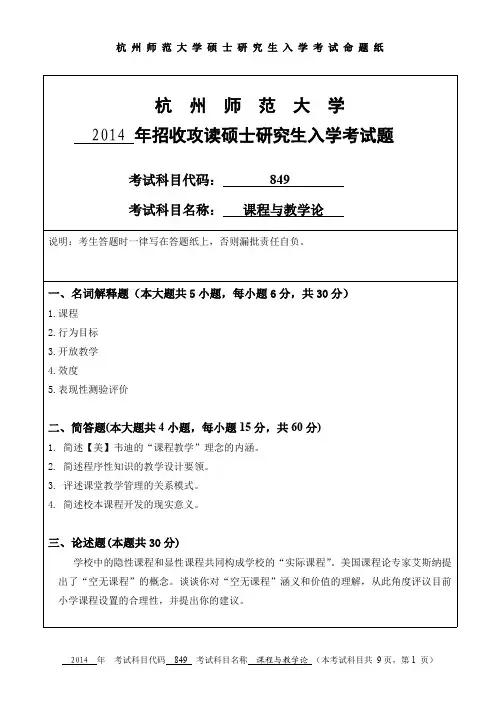
杭州师范大学2014年招收攻读硕士研究生入学考试题考试科目代码:849考试科目名称:课程与教学论说明:考生答题时一律写在答题纸上,否则漏批责任自负。
一、名词解释题(本大题共5小题,每小题6分,共30分)1.课程2.行为目标3.开放教学4.效度5.表现性测验评价二、简答题(本大题共4小题,每小题15分,共60分)1. 简述【美】韦迪的“课程教学”理念的内涵。
2. 简述程序性知识的教学设计要领。
3. 评述课堂教学管理的关系模式。
4. 简述校本课程开发的现实意义。
三、论述题(本题共30分)学校中的隐性课程和显性课程共同构成学校的“实际课程”。
美国课程论专家艾斯纳提出了“空无课程”的概念。
谈谈你对“空无课程”涵义和价值的理解,从此角度评议目前小学课程设置的合理性,并提出你的建议。
四、教学设计题(本大题根据自己的专业特长2选1,即选做其中的1题即可,每小题30分,共30分)1. 根据提供的一年级上册语文教材内容《棉花姑娘》,设计一个语文教案,教案要体现语文学科的特点,符合一年级学生的认知心理。
2. 根据提供的四年级下册数学教材内容《分数的初步认识》,设计一个数学教案,教案要体现数学的学科特点,符合四年级学生的认知心理。
杭州师范大学2016年招收攻读硕士研究生入学考试题考试科目代码:852考试科目名称:课程与教学论说明:考生答题时一律写在答题纸上,否则漏批责任自负。
一、名词解释(本大题共5小题,每小题6分,共30分)1. 学科课程2. 课程实施3. 教学模式4. 特朗普制5. 校本课程二、简答题(本大题共4小题,每小题15分,共60分)1. 简述影响课程发展的外部因素。
2. 概述自主探究的教学模式。
3. 简述班级授课制的优点及不足之处。
4. 简述质性评价的基本方法。
三、论述题(本大题共1小题,每小题30分,共30分)1.结合当前的基础教育课程改革,谈谈我国小学教学评价存在的问题及发展趋势。
四、设计题(两题中选做一题即可;本大题共1小题,每小题30分,共30分)根据所提供的二年级语文教材内容《一分钟》或一年级数学教材内容《认识钟表》,设计一个教案,要求既体现学科特点,又符合学生认知心理特征。
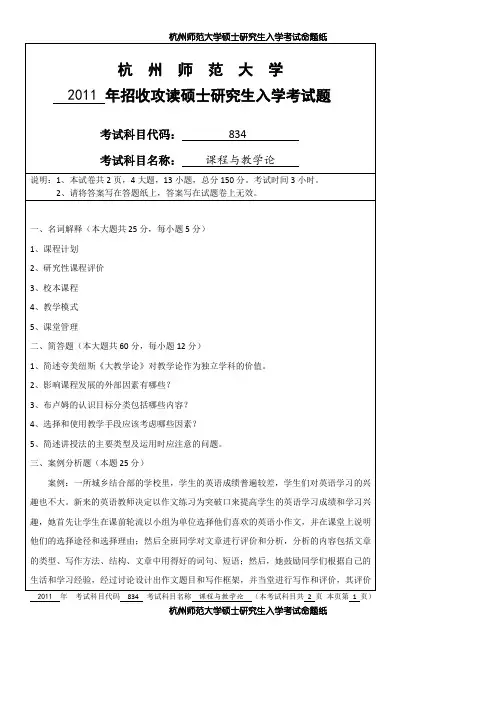
杭州师范大学硕士研究生入学考试命题纸2011年考试科目代码834 考试科目名称课程与教学论(本考试科目共2 页本页第1 页)杭州师范大学硕士研究生入学考试命题纸2011年考试科目代码834 考试科目名称课程与教学论(本考试科目共2 页本页第2 页)C.动作技能领域D.思维领域 8.判断教学是否优化,必须有一定的标准。
优化教学的一般标准包括( ) A.目标标准 B.质量标准 C.效率标准 D.过程标准 9.在教学过程中教师不把现成的结论告诉学生,而是让学生在教师的指导下自主地发现问题、探究问题、获得结论的方法称为( ) A.实验法 B.研究法 C.讨论法 D.实习法 10. 强调把一切知识教给一切人的“泛智教育说”的创立者为( ) A.赫尔巴特 B.斯宾塞 C.夸美纽斯 D.卢梭 三、简答题(本大题共4小题,每小题10分,共40分) 1. 简述“传统教学论”与“现代教学论”的代表人物及其基本观点。
2. 简述怎样根据泰勒模式进行校本课程的开发? 3. 简述课程实施的几种基本取向。
4. 简述当前小学教学方法改革和发展的基本趋势。
四、论述题(本大题共2小题,每小题20分,共40分) 1.“教学本质上是一种特殊的认识活动”;“教学是一种师生之间的交往活动”;“教学即对话” ……关于教学本质一直存在诸多论争,请你谈谈你对教学本质的认识。
2.自2001年我国第八次新课程改革以来,社会各界与不同学者对新课程改革褒贬不一。
比如,就新课程的理论基础,一些学者认为新课程改革引进了西方的大量理论,或实用主义理论,或建构主义理论,或多元智力理论,或后现代主义思想等,理论驳杂,零碎,含混模糊,自相矛盾;另一些学者认为,新课程改革理论“博采众长、避免偏窄,眼界宽广、高瞻远瞩”。
你认为新课程改革的理论基础符合国情吗?你是怎么评价新课程改革的? 五、案例分析题(本大题共1小题,每小题20分,共20分) 随着新课程改革的不断推进,现在的中小学课堂在教学组织形式上也在不断创新。
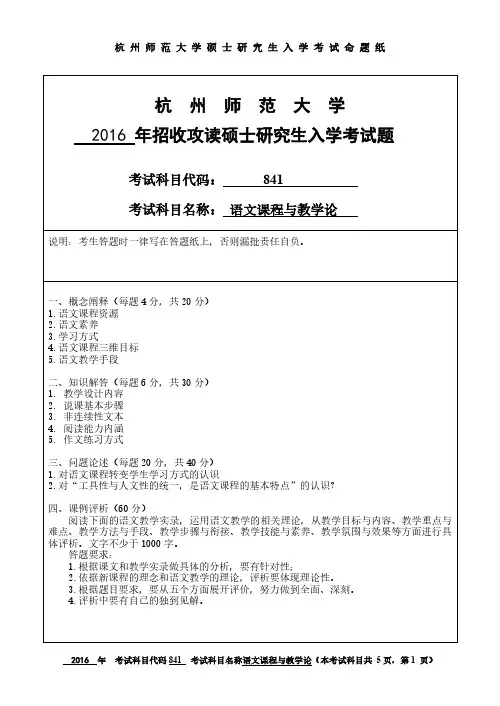
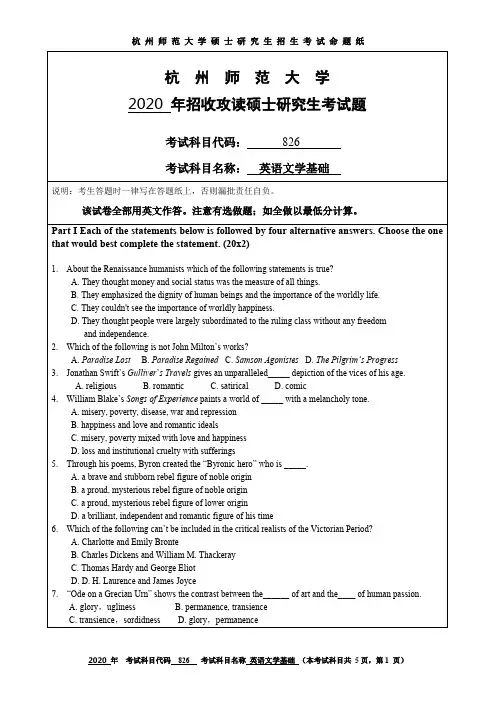
杭州师范大学2020年招收攻读硕士研究生考试题考试科目代码:826考试科目名称:英语文学基础说明:考生答题时一律写在答题纸上,否则漏批责任自负。
该试卷全部用英文作答。
注意有选做题;如全做以最低分计算。
Part I Each of the statements below is followed by four alternative answers. Choose the one that would best complete the statement. (20x2)1. About the Renaissance humanists which of the following statements is true?A. They thought money and social status was the measure of all things.B. They emphasized the dignity of human beings and the importance of the worldly life.C. They couldn't see the importance of worldly happiness.D. They thought people were largely subordinated to the ruling class without any freedomand independence.2. Which of the following is not John Milton’s works?A. Paradise LostB. Paradise RegainedC. Samson AgonistesD. The Pilgrim’s Progress3. Jonathan Swift’s Gulliver’s Travels gives an unparalleled_____ depiction of the vices of his age.A. religiousB. romanticC. satiricalD. comic4. William Blake’s Songs of Experience paints a world of _____ with a melancholy tone.A. misery, poverty, disease, war and repressionB. happiness and love and romantic idealsC. misery, poverty mixed with love and happinessD. loss and institutional cruelty with sufferings5. Through his poems, Byron created the “Byronic hero” who is _____.A. a brave and stubborn rebel figure of noble originB. a proud, mysterious rebel figure of noble originC. a proud, mysterious rebel figure of lower originD. a brilliant, independent and romantic figure of his time6. Which of the following can’t be included in the critical realists of the Victorian Period?A. Charlotte and Emily BronteB. Charles Dickens and William M. ThackerayC. Thomas Hardy and George EliotD. D. H. Laurence and James Joyce7. “Ode on a Grecian Urn” shows the contrast between the______ of art and the____ of human passion.A. glory,uglinessB. permanence, transienceC. transience,sordidnessD. glory,permanence8. The term “metaphysical poetry” is commonly used to name the work of the 17th century writers who wroteunder the influence of _____.A. John MiltonB. John DonneC. John KeatsD. John Bunyan9. In The Pilgrim’s Progress Christian and Faithful come to the ______where both are arrested as alienagitators and tried.A. Vanity FairB. Doubting CastleC. Celestial CityD. The Valley of Humiliation10. Of the following poets, who is not regarded as “lake poet”?A. Samuel Taylor ColeridgeB. Robert SoutheyC. William WordsworthD. John Keats11. ________, a Gothic novel written by Mary Shelley, is one of the triumphs of the Romantic movement dueto its theme of alienation and its warning about the destructive power that can result when human activity is unfettered by moral and social concerns.A. WaverleyB. EndymionC. Joan of ArcD. Frankenstein12. Which of the following statements about the Romantic period in the history of American literature is NOTtrue?A. Most heroes and heroines in the writings of this period exhibited extremes of reason and rationality.B. In most of the writings of this period there was a new emphasis upon the imaginative and emotionalqualities of literature.C. There were a strong tendency to exalt the individual and the common man.D. The writers of this period placed an increasing emphasis on the free expression of emotions anddisplayed an increasing attention to the psychic states of their characters.13. The common thread throughout American literature has been the emphasis on the___.A. revolutionismB. reasonC. individualismD. rationalism14. Although realism and naturalism were products of the 19th century, their final triumph came in the 20th century, with the popular and critical successes of such writers as Edwin Arlington, William Cather, Robert Frost, William Faulkner and_____.A. Edgar Allan PoeB. Sherwood AndersonC. Washington IrvingD. Ralph Ellison15. ____, one of the essays in The Sacred Wood, is the earliest statement of T.S. Eliot’s aesthetics, which provided a useful instrument for modern criticism.A. “Tradition and Individual Talent”B. “Sweeny Agonistes”C. “A Primer of Modern Heresy”D. “Gerention”16. The three poets Ezra Pound, T.S. Eliot and ____ opened the way to modern poetry.A. O. HenryB. Henry David ThoreauC. E.E. CummingsD. Robert Frost17. Which writer best expressed the Puritan sense of the self?A. Jonathan EdwardsB. Cotton MatherC. John SmithD. Thomas Hooker18. Which is generally regarded as the Bible of New England Transcendentalism?A. WaldenB. NatureC. “On Beauty”D. “Self-Reliance”19. Which is regarded as the “Declaration of Intellectual Independence” in the history of American Literature?A. The American ScholarB. English TraitsC. The Conduct of LifeD. Representative Men20. Imagism was equivalent to ___ in fiction in a sense. Imagist never stated the emotion in the poem, but justpresented an image: concrete, firm and definite in picture.A. modernismB. romanticismC. naturalismD. surrealismPart II Identify the source of each of the following quotation and write out the TITLE of which the passage comes from.(20x1)1. Whan Zephirus eek with his sweete breeth/Inspired hath in every holt and heeth/The tendercroppes, and the Yonge sonne/Hath in the Ram his half coursy ronne,2. The quality of mercy is not strained;/It droppeth as the gentle rain from heaven/ Upon theplace beneath. It is twice blest:3. If they be two, they are two so/As stiff twin compasses are two:/Thy soul, the fixed foot,makes no show/To move, but doth if th’other do;4. All is not lost-----the unconquerable will,/ And study of revenge, immoral hate,/And couragenever to submit or yield:5. These people are most excellent mathematicians, and arrived to a great perfection inmechanics by the countenance and encouragement of the Emperor, who is a renowned patron of learning.6. True wit is Nature to advantage dressed,/What oft was thought, but ne’er so well expressed;7. So here have I lived above sixteen years in virtue and reputation; and all at once, when Icome to know what is good, and what is evil, I must renounce all the good, all the whole sixteen years’ innocence, which, next to God’s grace, I owed chiefly to my parents and to my lady’s lessons and example.8. As fair art thou, my bonnie lass,/So deep in luve am I;/ And I will luve thee still, my dear,/Till a’ the seas gang dry.9. No Nightingale did ever chaunt/ More welcome notes to weary bands/ Of travelers in someshady haunt,/ Among Arabian sands:10. It is a truth universally acknowledged, that a single man in possession of a good fortune mustbe in want of a wife.11. Wild Spirit, which art moving everywhere;/ Destroyer and Preserver; hear, O hear!12. He listened. The wind, playing upon the edifice, produced a booming tune, like the note ofsome gigantic harp.13. What a handsome little Oriental he was, and no doubt his wife and children were beautifultoo, for people usually get what they already possess.14. This train of thought, she perceives, is threatening mere waste of energy, even some collisionwith reality, for who will ever be able to lift a finger against Whitaker’s Table of Precedency?15. He hated her bitterly at that moment because he made her suffer. Love her! She knew heloved her. He really belonged to her. This about not loving her, physically, bodily, was a mere perversity on his part.16. They were all running, all crying out madly. He could hear them crashing in the undergrowthand on the left was the hot, bright thunder of the fire.17. “I sometimes have a queer feeling with regard to you-----especially when you are near me, asnow; it is as if I had a string somewhere under my left ribs, tightly and inextricably knotted toa similar string situated in the corresponding quarter of your little frame.”18. This grew; I gave commands;/ Then all smiles stopped together.19. Although schoolmistresses’ letters are to be trusted no more nor less than churchyardepitaphs; yet, as it sometimes happens that a person departs this life, who is really deserving of all praises the stone-cutter carves over his bones;20. Yet all experience is an arch wherethrough/ Gleams that untraveled world whose marginfades/ Forever and forever when I move.Part III In this part, you are free to choose Any TWO of the following three literary terms, and define them. (20x2)1. Stream of consciousness2. Conceit3.TranscendentalismPart IV. Choose ONE of the two topics and elaborate your views. (25x1)1. In 1954, William Golding(1911-1993) published his first novel Lord of the Flies after nearly21 rejections of various publishers. This fiction,since its publication, has been considered as adystopian allegory indicative of vast aspects of the human condition, in terms of human evil and society.Elaborate your view on this novel.2. Eugene O’Neill(1888-1953) was the first American dramatist to regard the stage as a literarymedium and the only American playwright ever to receive the Nobel Prize for Literature.Through his efforts, the American theatre grew up during the 1920s, developing into a cultural medium that could take its place with the best in American fiction, painting, and music. Elaborate your view on his works.Part V. Read the following two commentaries carefully and choose ONE topic to write out your own ideas in any relationship to the passage. (25x1)1. Poetry, as we have since learnt, has other tasks than that of imparting psychological values tothe visible world. Had Wordsworth turned his attention toward these, his genius might not have atrophied so soon. It remains to indicate briefly, in conclusion, what gave Wordsworth his initial direction towards “Nature” as the inevitable raw material for his creative sensibility. Here we met, I think, with two other groups of beliefs current in his age, which may be said to have conditioned his poetic experience: postulates (‘doctrines-felt-as-facts’) without which his poetry would not have been what it actually is. The first was the product of the deistic tradition of the seventeenth and eighteenth centuries, to which I have already alluded in passing. Ever since the Renaissance the Creation had been steadily gaining in prestige as the ‘art of God,’ the universal divine Scripture which ‘liesexpans’d unto the eyes of all.’ The emotion of the ‘numinous,’ formerly associated with super-nature, had become attached to Nature itself; and by the end of the eighteenth century the divinity, the sacredness of nature was, to those affected by this tradition, almost a first datum of consciousness.Wordsworth, then, did not have to construct this belief wholly out of his experience; much of it was given to him. Much the same is true of the second of these fundamental beliefs, the belief in the grandeur and dignity of man, and the holiness of the heart’s affections. This, too,was the products of forces originating (for our purposes) in the Renaissance; it had arisen out of the ruins of the theological view of man. As the ‘Fall’ receded further and further into the region of fable, man was increasingly regarded as a creature not only made in, but retaining, God’s image; and Wordsworth could acknowledge, without misgiving, ‘a grandeur in the beatings of the heart,’ and speak in good faith of ‘man and his noble nature.’ In Wordsworth’s lifetime this humanism had taken a colouring from Rousseau, and the special nobility of man was therefore only to be looked for ‘in huts where poor men lie.’ The ‘higher’ grades of society, in which the culture of the Renaissance had been exclusively fostered, were now “A light, a cruel, and vain world, cut off/From the natural inlets of just sentiment,/From lowly sympathy, and chastening truth.” [From “On Wordsworth and the Locke Tradition” by Basil Willey]2. Poetic influence is a labyrinthine process, and at its deepest is remote from echo and allusion,though it does not exclude them…When Whitman tallies he takes measures of all things, implicitly including the measure of his own poetry. In his very different way, Whitman is as formalist a poet as were our late contemporaries James Merrill and Anthony Hecht, who usefully may be contrasted to the late A. R. Ammons and to John Ashbery, both of them strongly influenced by the poet of Leaves of Grass. Ammons and the versatile Ashbery can be far freer in form than Whitman ever is. The King James Bible is the largest influence upon Whitman’s style, and the Hebrew parallelism breaks through in the strongest of the translators, William Tyndale and Miles Coverdale. There is no single measure to Whitman’s song, just as his huge enlargements transcend all previous notions as to what can constitute materiapoetica. To hold together the vastness of his topics and the fluid dissolves of his tropes Whitman had to discover a master metaphor and found it in the tally, at once his ‘confession sprig’ and his incanted warbles for lilac-time. The Whitmanian tally is the binding agent for “When Lilacs last in the Door-yard Bloom’d,” the sonorous elegy for the martyred Abraham Lincoln. Together with “As I Ebb’d with the Ocean of Life,” “Lilacs” is the most formally measured of Whitman’s peoms. I have a passion for “Lilacs,” though the epic “Song of Myself” is certainly the center of the Whitmanian poetic cosmos. Henry and William James, T. S. Eliot(belatedly), and Wallace Stevens all associated “Out of the Cradle Endlessly Rocking” with “Lilacs” because there is a clear affinity between the mockingbird’s song and the song of death warbled by the hermit thrush. The boy Whitman first beholds the mockingbird “when the lilac-scent was in the air.” The crucial difference between “Out of Cradle” and “Lilacs” seems to me that the sea in the first poem lisps the low and delicious word death, which becomes the burden of hermit thrush’s song in “Lilacs.” In the earlier poems, the male mockingbird sings of bereavement but not of death, though that is implied.Why did Whitman choose the word tally for what I judge to be his comprehensive vision of poetic voice? The word has a curious history. It derives from the Latin talea, which means a cutting, rod, or stick, on which you record payments and the sum still owed. In English, it transmuted into the idea of a duplicate or other half. It then became associated with illicit love. To live “tally” was to dwell together without marriage. In time the word expanded to become tally-whacking, tally woman, and tally-wags. [From The Anatomy of Influence: Literature as a Way of Life by Harold Bloom]。
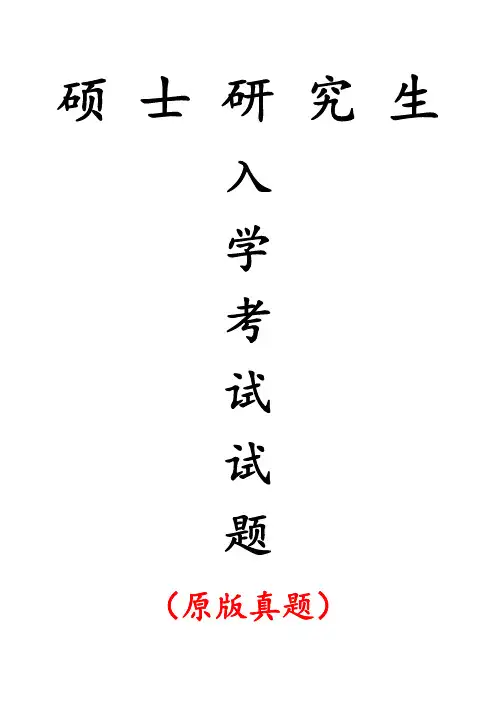
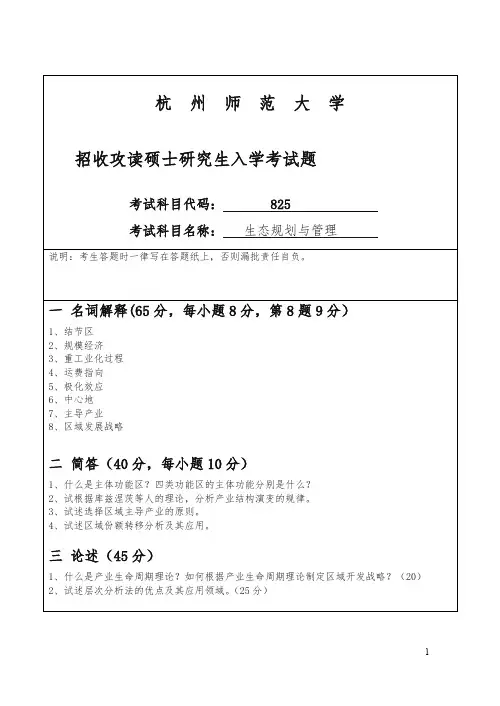
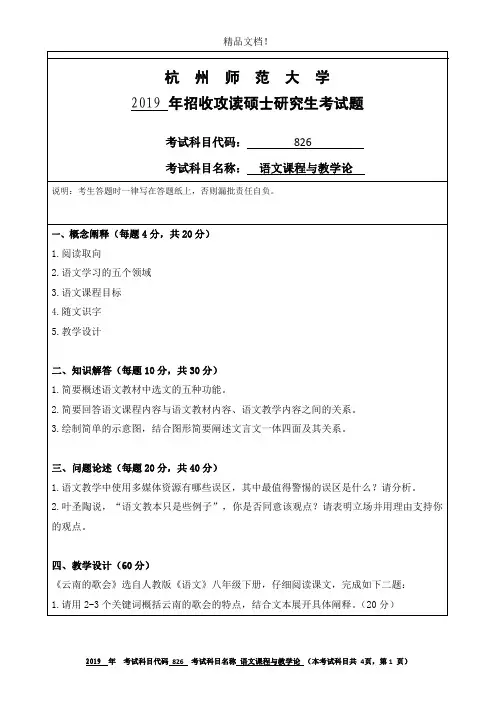
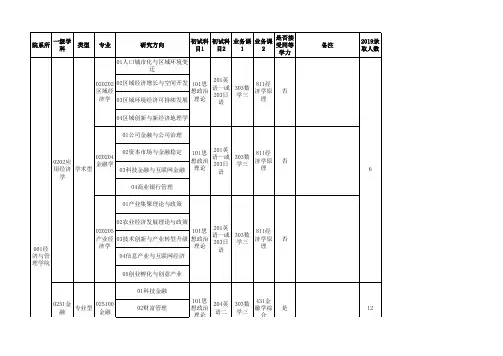
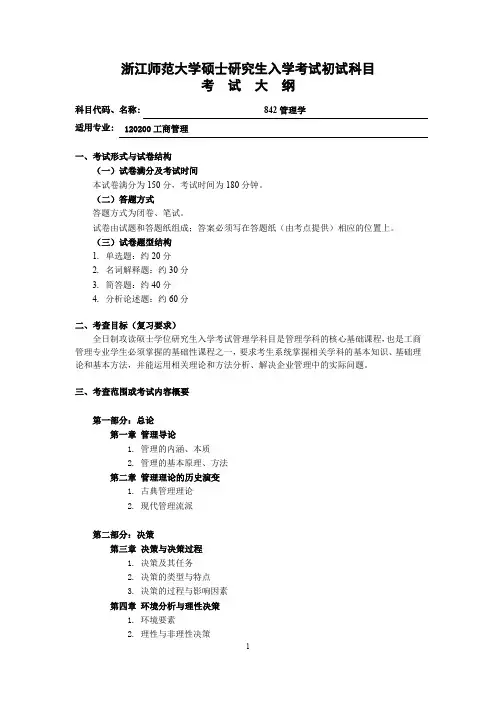
浙江师范大学硕士研究生入学考试初试科目考试大纲科目代码、名称: 842管理学适用专业: 120200工商管理一、考试形式与试卷结构(一)试卷满分及考试时间本试卷满分为150分,考试时间为180分钟。
(二)答题方式答题方式为闭卷、笔试。
试卷由试题和答题纸组成;答案必须写在答题纸(由考点提供)相应的位置上。
(三)试卷题型结构1. 单选题:约20分2. 名词解释题:约30分3. 简答题:约40分4. 分析论述题:约60分二、考查目标(复习要求)全日制攻读硕士学位研究生入学考试管理学科目是管理学科的核心基础课程,也是工商管理专业学生必须掌握的基础性课程之一,要求考生系统掌握相关学科的基本知识、基础理论和基本方法,并能运用相关理论和方法分析、解决企业管理中的实际问题。
三、考查范围或考试内容概要第一部分:总论第一章管理导论1. 管理的内涵、本质2. 管理的基本原理、方法第二章管理理论的历史演变1. 古典管理理论2. 现代管理流派第二部分:决策第三章决策与决策过程1. 决策及其任务2. 决策的类型与特点3. 决策的过程与影响因素第四章环境分析与理性决策1. 环境要素2. 理性与非理性决策3. 决策方法第五章决策的实施与调整1. 实施决策的计划制定2. 推进计划的流程与方法3. 决策追踪与调整第三部分:组织第六章组织设计1. 组织设计的任务与影响因素2. 组织结构3. 组织整合第七章人员配备1. 人员配备的任务、内容和原则2. 人员的选聘3. 人员的考评4. 人员的培训第八章组织文化1. 概述2. 构成与功能第四部分:领导第九章领导的一般理论1. 领导的内涵与特征2. 领导与领导者3. 领导与被领导者4. 领导与情境第十章激励1. 激励基础2. 激励理论3. 激励方法第十一章沟通1. 沟通与沟通类型2. 沟通的障碍及其克服3. 冲突与管理第五部分:控制第十二章控制类型与过程1. 控制内涵与原则2. 控制的类型3. 控制过程第十三章控制方法与技术1. 层级、市场与团体控制2. 质量控制第十四章风险控制与危机管理1. 风险识别与分析2. 危机管理第六部分:创新第十五章创新管理1. 管理创新类型与基本内容2. 创新过程及其管理第十六章组织创新1. 组织变革与创新2. 组织结构创新3. 创新与学习型组织主要参考书:管理学.《管理学》编写组.高等教育出版社,2019 四、样卷无。
2020年硕士研究生入学考试科目《卫生事业管理学》考试大纲
(注:尽可能详细!)参考书张亮、胡志主编.人民卫生出版社、2013年8月
考试内容
主要考试内容主要包括覆盖卫生事业管理学绪论、卫生方针与卫生发展战略、卫生法与卫生政策、卫生管理体制与机制、卫生组织体系及资源规划管理、卫生资金及物力管理、卫生人力资源管理、卫生信息管理、社会健康资源与社区健康服务管理、医疗与公共卫生服务管理、药品服务管理、传统医学服务管理、卫生服务整合管理、健康评价及控制、卫生系统及服务机构绩效评价与控制等基本理论与方法,我国2009年以来新一轮医药卫生体制改革的主要政策与动态,以及应用基本理论、方法思辨解决医疗卫生管理实际问题的能力考察。
试卷内容结构基本概念、理论与方法等客观性内容约占35%,论述及材料分析主观性内容约占65%。
试卷难易结构中等难度
试卷题型结构名词解释、判断题、简述题、案例材料分析及论述题
试卷分值结构名词解释(30分)、判断题(20分)、简述题(50分)、案例材料分析及论述题(50)
评分标准和要求能够较准确地理解和掌握卫生事业管理学的基本概念、理论与方法,材料分析及论述题紧密联系案例材料和卫生健康事业改革与发展的实际和趋势,且有自己独特的观点和见解,论述逻辑层次清晰,文字表述准确、流畅。
备注
一级学科硕士点召集人签名:(学院盖章)学院分管院长签名:。
2020 年硕士研究生(学术学位)招生初试科目考试大纲科目代码: 821科目名称:《机械设计基础》(含机械原理和机械设计)适用专业:机械工程一、考试要求机械设计基础(含机械原理和机械设计)适用于重庆工商大学机械工程专业研究生招生专业课考试。
课程重点要求考生系统深入地掌握机械原理和机械设计的基本知识、基本理论和基本设计计算方法,并且能灵活运用。
重点考察分析与解决常用机构、通用机械零部件和简单机械装置设计问题的能力。
二、考试形式与题型考试为闭卷,考试时间180分钟,满分为150分。
试卷题型包括名词解释、简答题、计算题、分析题等。
三、考试内容机械设计基础(含机械原理和机械设计),其中机械原理部分占50%,机械设计部分占50%。
机械原理部分:(一)平面机构的结构分析1. 机构的构成:运动副的概念和运动副的类型;运动链;机构。
2. 机构运动简图:常用机构运动简图符号;平面机构运动简图的识别与绘制。
3. 机构具有确定运动的条件:机构自由度的概念;机构具有确定运动的条件;平面机构的自由度计算方法。
4. 机构组成原理:基本杆组的概念;机构组成原理;机构的结构分类及结构分析。
(二)平面机构运动分析及力分析1. 速度瞬心法:瞬心的定义;平面机构瞬心位置的确定;瞬心在平面机构速度分析中的应用。
2. 矢量方程图解法II 级机构运动分析:矢量方程图解法的基本原理;应用矢量方程图解法对平面II 级机构进行速度分析。
3. 考虑摩擦时机构受力分析:常见平面运动副(移动副、转动副、高副)中总反力作图分析;考虑摩擦时平面机构的受力分析与平衡力计算。
(三)平面连杆机构及其设计1. 平面连杆机构的类型:铰链四杆机构的基本形式;平面四杆机构的演化形式。
2. 平面四杆机构的基本知识:铰链四杆机构有曲柄的条件;平面四杆机构的急回运动和行程速度变化系数;极位夹角、压力角、传动角、死点位置的概念与求取。
3. 平面四杆机构的运动设计:按连杆给定位置、按连架杆给定对应位置设计铰链四杆机构;机构倒置原理;按行程速比系数设计平面四杆机构。